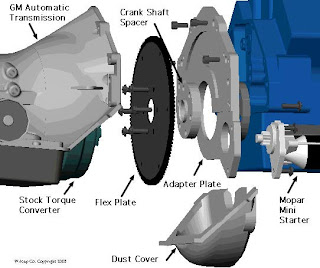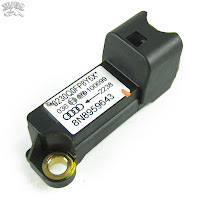The Electronic Transmission TTEC 4825
1. The basic function of the torque converter is to multiply the turning force of an engine while at the same time replacing the clutch found in manual transmissions.
2. The bands and clutches in an automatic transmission; the band holds the sun gear, disc brakes used to hold the rear carrier when the selector is in 1, and a one-way clutch is used for a similar purpose when the selector is in Drive.
3. The Planetary gear set in an automatic transmission has a ring gear, pinion gears in a planet carrier and a sun gear all of these gears are in constant mesh and do not slide. The gear ratios are obtained by holding one of the other parts still with a brake another part then acts as a driver and the third is driven.
4. The neutral-safety switch/inhibitor switch in an automatic transmission prevents the vehicle from starting in D, 1, 2, 3, or R
5. The common inputs needed for an Electronic Transmission
· Air Conditioning Clutch – if the air con is on hi then rpm is increased to compensate for the loss of power
· Brake On/Off Switch
· Profile Ignition Pickup Signal from Edis Module
· Mass Air Flow Sensor
· Output Shaft Speed Sensor
· Vehicle Speed Sensor – provides info for the shift chart to change the length each gear is held
· Engine Coolant Temp Sensor
· Manual Lever Position Sensor
· Transmission Oil Temp Signal
· Throttle Position Sensor – provides info for the shift chart to change the length each gear is held
· Air Charge Temperature sensor
6. Common outputs used in an Electronic Transmission.
· Shift Solenoid 1
· Shift Solenoid 2
· Modulated Converter Clutch Control Solenoid
· Electronic Pressure
The line pressure has the effect of changing the shifting stiffness of an electronic transmission, the more pressure the harder/jerkery the shift but wear is decreased
The vehicle speed affects the shifting through different gears in an electronic transmission by using a shift chart so that as speed increases the gear shifts are held longer
Torque converter slippage is controlled A speed sensor is used to measure vibrations transmitted through the torque converter to the driveline of the vehicle. The sensor signal is sent to an analyzing system where it is converted to the frequency domain. A separate minimum slip value for each selected engine speed and transmission gear is stored in a table so that during vehicle operation, a controller will instruct the torque converter clutch to set the desired converter slip for the current engine speed and transmission gear provided for a particular throttle position and/or engine torque.
8. Switches on the gearshift or nearby are the overdrive on/off limits the transmissions to one gear below top, hold – holds the current selected gear, and power/economy affects the throttle opening at which gear changes take place.
9. Using the Holden shift chart on the next page, if no solenoids are working, and the customer tries to drive the car from a stop sign they will only have 3rd gear so take off will be slow
10. If the #2 solenoid has an open/off, how will the transmission shift through the gears as the vehicle drives from a stop sign? It will be slow to take off because of the high gearing Only have 3rd and 4th
11. The shifting pattern will be reset, if the battery was disconnected for a long time. Memory will be lost and the TCU will have to relearn the driver’s style of driving, this may cause a decrease in performance.
two transmission codes out of repair information;
Code 45 Damaged or disconnected wiring of the pressure-control solenoid valve system
what the code means Check the solenoid valve connector, check the pressure - control solenoid valve itself.
Code 24 Damaged or disconnected wiring of the oil-temperature sensor system
Check the oil-temperature sensor connector,and the sensor itself.
Future development
The next generation of the BMW flagship sedan will come with an all new 8-speed automatic transmission. Mercedes already has a 7 speed automatic gearbox and Lexus has a new 8-speed already on offer. The high fuel prices and the ever tightening emission norms have fueled the need for efficient automatics.
The BMW’s new 8 Speeder fits in the same space as the old 6 Speeder and it smoother and more efficient than the older gearbox. The new gearbox will filter down to other BMW models as well after its initial launch in the upcoming BMW 7 Series. The new gearbox will also make the gear selector to come to the console from its previous stalk position, a welcome change for many.
Source: Bimmerfile.com
From these notes I found it interesting the amount of practical skills I learnt.
ABS
Airbag SRS Notes (supplement restraint system)
An airbag is a vehicle safety device. It is an occupant restraint consisting of a flexible envelope designed to inflate rapidly in an automobile collision, to prevent vehicle occupants from striking interior objects such as the steering wheel or window. Note that the gas and powder in an air bag is not dangerous.
(1) Driver seat slide position sensor
(2) Side and curtain inflators and air bags
(3) Driver/Front passenger dual stage inflators and air bags
(4) Air bag/front seat belt pretension system warning light
(5) Crash, roll-over sensors and diagnostic module (SAS unit)
(6) Front passenger air bag deactivation indicator light
(7) Front air bag sensor
(8) Side crash sensors
(9) Front seat belt pretension and load limiting systems
(10) Front passenger seat weight sensors
(11) Front passenger seat weight sensor control module
(12) Driver and front passenger seat belt buckle switches
Self Diagnostic test
Key on dash light comes on and goes out after 6 seconds, in Toyotas the light comes on with accessory. This light will stay on/flash if there is a fault in the air bag system and the airbags will be deactivated.
Service and Airbag safety
Check the condition of the air bag cover for dents, cracks or warping
Do not try to dismantle an air bag, only carefully take them out as an assembly, carry them horn facing towards yourself at arm’s length, place on a clear clean work bench face up and don’t connect them to any power source. And do not drop or shock or place magnets near mechanical air bags.
Check the crash sensors are mounted right if being replaced and straighten any bent brackets,
Mechanical air bags don’t have electrics - warning lights, diagnostics.
Check the steering wheel or sun visor, always wear a seat belt.
Airbags are connected to battery and to a battery backup(capacitors) and in the ECU for at least half an hour, for the exact time(down to 1min) check the service manual, it is good practice to remove both battery terminal, tape up or remove the battery, touch the positive lead to earth to discharge.
Air Bag wiring harness are bright yellow or orange to warn you not to test them.
Never lie across a steering wheel when working on the vehical
Never do a resistance test with, test the rest of the circuit for faults; ECU connections, grounds, clock springs next use a 2ohms resistor in place of the resistor if the check air bag, fault code or air bag light goes out, the air bag needs replacing – has a cost of about $1200
Never lie across a steering wheel when working on the vehical
Never do a resistance test with, test the rest of the circuit for faults; ECU connections, grounds, clock springs next use a 2ohms resistor in place of the resistor if the check air bag, fault code or air bag light goes out, the air bag needs replacing – has a cost of about $1200
Airbag fatality statistics Good and bad
From 1990 to 2008, the U.S. National Highway Traffic Safety Administration identified 175 fatalities caused by air bags. Most of these (104) have been children, while the rest are adults. About 3.3 million air bag deployments have occurred and the agency estimates more than 6,377 lives saved and countless injuries prevented.
A rear-facing infant restraint put in the front seat of a vehicle places an infant's head close to the airbag, which can cause severe head injuries, or death if the airbag deploys. Some modern cars include a switch to disable the front passenger airbag (although not in Australia, where rear-facing child seats are prohibited in the front where an airbag is fitted); in case a child-supporting seat is used there.
In vehicles with side airbags, it is dangerous for occupants to lean against the windows, doors, and pillars, or to place objects between themselves and the side of the vehicle. Articles hung from a vehicle's clothes hanger hooks can be hazardous if the vehicle's side curtain airbags deploy. A seat-mounted airbag may also cause internal injury if the occupant leans against the door.
Curtain airbags (see link above for a video) have been said to reduce brain injury or fatalities by up to 45% in a side impact with an SUV. These airbags come in various forms (e.g., tubular, curtain, door-mounted) depending on the needs of the application. Many recent SUVs and MPVs have a long inflatable curtain airbag that protects all 3 rows of seats. These airbags each have their own sensor so that if an impact occurs to one side of a vehicle that specific air bag can deploy alone. This would have to be decided by the electronic module to determine the force of the crash and whether or not to deploy.
From these notes I learnt the basic theory of how to diagnose and replace airbags and was reminded of how they work to protect human life.
References
Automotive Mechanics, Vol 2, 8th ed, May, Simpson






No comments:
Post a Comment